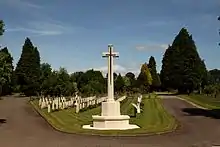Cathays Cemetery
The Cathays Cemetery is one of the main cemeteries of Cardiff, Wales. It is in the Cathays district of the city, about 1.5 miles (2.4 km) north of Cardiff city centre. At 110 acres it is the third largest cemetery in the United Kingdom.[1] It is listed on the Cadw/ICOMOS Register of Parks and Gardens of Special Historic Interest in Wales.
| Cathays Cemetery | |
|---|---|
 Cathays Cemetery | |
| Details | |
| Established | 1859 |
| Location | |
| Country | Wales |
| Coordinates | 51.5017°N 3.1808°W |
| Owned by | Cardiff Council |
| Website | Cathays Cemetery |
| Find a Grave | Cathays Cemetery |
History

The cemetery was opened in 1859 and originally had two chapels: one Anglican and the other non-conformist,[2] and each including its own porte-cochère. The cemetery has a Roman Catholic section, where a Roman Catholic chapel was built later.[2]
In the Second World War, air raids damaged Cathays Cemetery with a number of bombs and an aerial mine.[3] During the early/mid 1970s the cemetery was split into two sections to allow the building of the A48 Eastern Avenue which was a continuation of the A48(M). In the 20th century all three chapels were neglected and in the 1980s the Roman Catholic one was demolished.[2] Since 2008 the Anglican and non-conformist chapels have been undergoing restoration.[2] One of the most imposing memorials is that of Frank Baselow, thought to be a result of Baselow's European heritage (his actual name was Franz) and the taste on the Continent for grand memorials.[1]
The two chapels, the cemetery house, and the gateway and forecourt walls, are Grade II listed buildings.[4][5][6] The cemetery itself is listed at Grade II on the Cadw/ICOMOS Register of Parks and Gardens of Special Historic Interest in Wales.[7]
War graves


The cemetery has a Commonwealth War Graves (CWGC) section, marked by a Cross of Sacrifice made to the standard design devised by Reginald Blomfield. The section was established in the First World War, when Cardiff's nearby main hospitals treated numerous servicemen who had been wounded in action, or who contracted influenza in the 1918–19 influenza pandemic.
The war graves section includes a number of graves of Australian and Canadian servicemen, one New Zealander who died while serving in the Royal Defence Corps, and one soldier of the Prince of Wales's Leinster Regiment. Also present is the grave of Jacques Vaillant de Guélis, a Special Operations Executive agent.[8] The cemetery includes the graves of 21 French Navy sailors from the First World War, mostly in the Roman Catholic section,[3] and a similar number of Norwegian sailors from the Second.[9] Elsewhere in the cemetery are numerous Commonwealth War Graves from both the First and Second World Wars. The cemetery contains the graves of 685 service personnel which are registered and maintained by the CWGC.[9] Victims of the Cardiff Blitz who are buried in the cemetery are commemorated by a memorial erected in 1993.
Notable interments
- Robert Bird, Liberal Party politician[10]
- Sir James Cory, 1st Baronet,[10] shipowner and Conservative Party politician
- Jim Driscoll,[10] boxer
- John Emlyn-Jones,[10] shipowner and Liberal politician
- John Humphrey England, founder of Edward England Potatoes.
- Louisa Maud Evans,[10] a young girl who died in a ballooning accident in 1896.
- John Cuthbert Hedley,[10] Roman Catholic bishop[11]
- Archibald Hood,[10] colliery owner
- Thomas Rowland Hughes,[10] writer
- David (Dai) Lewis, professional boxer murdered by Driscoll and Rowlands in 1927 (contested)
- Hilary Marquand,[10] Labour Party politician
- Sir William Henry Seager,[10] shipowner and Liberal politician
- Frances Batty Shand, founder of Cardiff Institute for the Blind
- Sir William Reardon Smith, 1st Baronet,[10] shipowner
- William Tatem, 1st Baron Glanely,[10] shipowner
- Sir Tudor Thomas,[10] ophthalmic surgeon
- Alfred Thomas, 1st Baron Pontypridd,[10] Liberal politician
- Maurice Turnbull,[10] Glamorgan and England cricketer
- Ernest Willows,[10] aviation pioneer and airship builder
- Several Senghenydd Colliery Disaster victims[10]
Notes
- "Cardiff cemeteries are home to many stories". Wales Online. 9 December 2010. Retrieved 7 December 2014.
- "History of the Cemetery". The Friends of Cathays Cemetery. Retrieved 10 June 2013.
- Cardiff Council 2006, p. 6.
- Cadw. "Mortuary Chapels at Cathays Cemetery (Grade II) (13683)". National Historic Assets of Wales. Retrieved 22 February 2023.
- Cadw. "Cemetery House, including stable in yard (Grade II) (25824)". National Historic Assets of Wales. Retrieved 22 February 2023.
- Cadw. "Gateway and forecourt walls to Cathays Cemetery (Grade II) (13682)". National Historic Assets of Wales. Retrieved 22 February 2023.
- Cadw. "Cathays Cemetery (PGW(Gm)19(CDF))". National Historic Assets of Wales. Retrieved 24 February 2023.
- "CWGC Casualty record, Jacques Vaillant de Guelis".
- "CWGC Cemetery Report".
- "People Buried At The Cemetery". The Friends of Cathays Cemetery. Retrieved 11 June 2013.
- "Bishop Hedley's Cathays Cemetery memorial restored and rededicated". BBC News. 31 January 2012. Retrieved 20 June 2013.
Sources and further reading
- Cathays Cemetery Cardiff on its 150th Anniversary. Cardiff: Friends of Cathays Cemetery. 2009.
- "Cathays Cemetery Heritage Trail". Cardiff Council. 2006. Archived from the original (pdf) on 26 September 2007.
External links
- The Friends of Cathays Cemetery
- "Cathays Cemetery". Find a Cemetery. Commonwealth War Graves Commission.
- Ryall, Gemma (21 March 2013). "Commonwealth war graves: 8,000 Wales plots signposted". BBC News. Retrieved 20 June 2013.
- Jones, Martyn. "Cathays Cemetery". Flickr. – photographs
- "Search Results: Cathays Cemetery". Geograph. – photographs
- Prior, Neil (24 July 2021). "Girl's tragic balloon accident death marked 125 years on". BBC News story of Louisa Maud Evans' death and commemoration. Retrieved 16 February 2023.